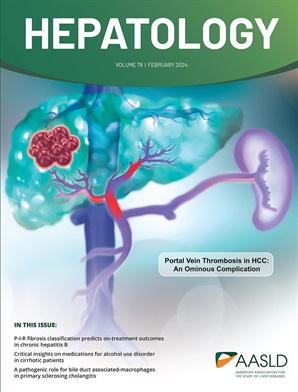Clinical outcomes and care for spontaneous bacterial peritonitis: A national cohort study
IF 12.9
1区 医学
Q1 GASTROENTEROLOGY & HEPATOLOGY
引用次数: 0
Abstract
Background & Aims: SBP leads to high rates acute kidney injury (AKI) -hepatorenal syndrome and mortality. Population-based studies on contemporary SBP epidemiology are needed to inform care. In a large, national cohort of patients diagnosed with SBP and confirmed by ascitic fluid criteria, we characterized ascitic fluid characteristics, in-hospital and 12-month mortality, AKI, and recurrent SBP. Approach & Results: We investigated how individual and bundled quality measures for SBP associated with outcomes after multi-level adjustment for health-system, patient clinical factors and quality measures. Individual and bundled quality metrics were inpatient antibiotics within 48 hours, intravenous albumin, repeat paracentesis within 48 hours, recognition of SBP, and prophylactic antibiotics upon discharge. Among 4,330 patients with newly diagnosed SBP, in-hospital mortality was 15.5% and 12-month mortality was 56.6%. The incidence of Stage 1 AKI was 26.6%, 15.7% for Stage 2, and 22.8% for Stage 3. The cumulative incidence of recurrent SBP was 10.3%. Guideline-recommended albumin was the only individual metric associated with reduced in-hospital mortality (HR 0.73, 95%CI 0.59 - 0.91). Receipt of a higher number of metrics from the SBP bundle was associated with progressively lower 12-month post-discharge mortality: patients who received 3, 4, and 5 SBP bundle components had 20%, 38%, and 56% lower hazard of mortality, respectively, relative to those receiving 2 or fewer (all求助全文
约1分钟内获得全文
求助全文
来源期刊

Hepatology
医学-胃肠肝病学
CiteScore
27.50
自引率
3.70%
发文量
609
审稿时长
1 months
期刊介绍:
HEPATOLOGY is recognized as the leading publication in the field of liver disease. It features original, peer-reviewed articles covering various aspects of liver structure, function, and disease. The journal's distinguished Editorial Board carefully selects the best articles each month, focusing on topics including immunology, chronic hepatitis, viral hepatitis, cirrhosis, genetic and metabolic liver diseases, liver cancer, and drug metabolism.
 求助内容:
求助内容: 应助结果提醒方式:
应助结果提醒方式:


